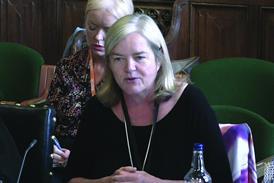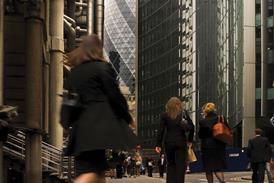
The low down
The unstable commercial policies of the Trump White House are pushing investor interest in UK commercial property and housing developments. But the interest is at the top end of the market, and comes with a sustained focus on any building’s environmental credentials. Clients wrongfooted by higher-than-expected interest rates and a sluggish transactions market are more willing to litigate, while insolvency instructions are rising. Adding to a difficult risk terrain, a judgment reversing a high-end property purchase that included unwanted moths has ‘put the fear of god into people’. Diverse practices are best placed to thrive.
Five years on from the pandemic, the UK’s commercial property sector is still coming to terms with the behavioural changes Covid brought to working habits. Alongside this, high interest rates and general economic uncertainty have meant that the mood across the real estate sector, while location-dependent, remains subdued. However, there are signs of optimism.
‘I think before the election, we had very high hopes that interest rates would come down fairly quickly,’ says Freeths partner Daniel Abrahams. ‘Inflation was under control, there’d been a rebasing or revaluation of quite a few assets, and there was interest in the UK as a stable government; there was going to be a real heyday. That didn’t particularly happen.’
He adds: ‘In terms of the market, my take on it is that it was a little patchy at best. We were lucky, in that we have quite a diverse practice, and we were able to pivot across a number of different areas.’
Cecily Davis, construction partner at Fieldfisher, also reflects on an uncertain commercial environment: ‘If I were to characterise 2025, I’d say it’s better than 2024, but perhaps not as good as we were hoping or expecting it to be.’
Leases are shorter, finances a bit trickier and the type of investor is perhaps slightly different. I’ve intentionally made sure that we have quite a diverse practice
Daniel Abrahams, Freeths
Global view
The annual MIPIM conference held in Cannes is attended by over 20,000 property sector professionals, investors and developers from 90 countries. Held last month, this conference provides a global barometer of the general mood. Attendee Annabelle Redman, partner at Clyde & Co, relates: ‘It’s quite nuanced at the moment. If you look at offices, there is a gradual return of confidence. I have dealt with buying and selling office buildings in the last 12 months, which we haven’t seen in a while, and that’s at different ends of the spectrum.
‘You’ve got the better-quality ones that are trading maybe at a bit of a discount, and you also have the lower end of the spectrum in terms of quality, which are not meeting their ESG requirements and are ripe for conversion. Sellers are being forced to sell at a discount, and they are being picked up by buyers who are turning them into residential or hotels.’
Figures released in January by US finance company MSCI showed that commercial property investment only started to recover from a two-year slump at the end of 2024, with most investors turning to residential properties and hotels and avoiding office buildings.
Uncertainty over future demand continues to dampen interest in office space, and many investors are re-evaluating their strategy to adapt to the market. In February, Landsec – one of the UK’s largest listed landlords – announced plans to sell £2bn of office buildings, and pivot towards residential and retail.
‘The idea of just buying long-term income [generating properties] for rent cheques [each] year is more challenging now,’ notes Abrahams. ‘Leases are shorter, finances a bit trickier and the type of investor is perhaps slightly different. I’ve intentionally made sure that we have quite a diverse practice. I have a lot of overseas clients, and there’s a lot of interest in the UK as the US is seen as being a slightly unpredictable market at the moment. There seems to be more value in UK and London assets.’

Moth dispute put ‘fear of god in people’
For property dispute lawyers, the flow of instructions has continued despite the slowdown in investment activity.
‘Property litigation work is quite hard to define because it isn’t just about running off to court,’ says Farrer & Co partner Jo Ord. ‘It is very much about advising and supporting the transactional teams. Our construction and commercial property teams are involved in a lot of placemaking, and we get involved at all stages of that. We are also seeing more insolvency work, more rent arrears and chasing more forfeiture, as well as advising on break clauses.
‘Times are tight and things are difficult, and that often makes people more willing to fight things they might not have fought before. We are still acting on the normal development issues that arise in a city, like rights of light, covenants and looking at how to get developments across the line. That is a bit of a constant work stream for us, and we are seeing a bit more of it.’
The recent landmark judgment in Iya Patarkatsishvili and Yevhen Hunyak v William Woodward-Fisher, decided in the High Court in February, has also ‘put the fear of god in people,’ says Brabners partner Helena Davies.
The case involved a moth infestation at a high-value property in London, with the claimant alleging that they had been induced to buy the property based on false representations made by the defendant relating to the infestation. The High Court allowed the claimants to return the house as well as receiving repayment of the purchase price along with interest and damages for costs incurred (see tinyurl.com/yc3jjsz6).
‘I’ve got two misrepresentation cases against sellers on the go,’ notes Davies, ‘and this case will really help me. The repercussions of the decision are significant.’
UK interest rates
A return to pre-pandemic buoyancy was sunk by a sharp rise in interest rates in the latter half of 2022. As interest rates have gradually fallen, some demand has returned to the office sector, though this has tended to be at the premium end of the market. Rents above £100 per sq metre are becoming more common.
However, these rates are not necessarily representative. ‘There is a tale of two cities,’ notes Clyde & Co partner Laura Oliver. ‘It’s the high-grade stuff versus the rest.’
Abrahams calls this ‘bifurcation’ of the office market: ‘It basically just means a dislocation. We’ve had the grade A space achieving some of the highest rents, and anything that’s a bit secondary or tertiary is still struggling.’
Environment-led
The green agenda is very much developer- and landlord-led, Abrahams says: ‘We’ve got clients who are looking to improve all of their air-handling systems, the air conditioning, and improving their EPC ratings. They are very much taking the lead on that.’
Davis observes that this push to greener buildings is not necessarily echoed by tenants: ‘We did a pulse survey of our clients at the end of last year and one of the questions was about green leases. Developers are, quite rightly, prioritising the desire to put very green products into the market, but there is a bit of a disconnect between what developers think tenants want and what they will pay for.’
Nonetheless, the growing demand for more sustainable practices throughout the real estate sector has meant that landlords continue to push ahead with green leases.
‘Investors have got very precious over their environmental performance, and their EPC ratings,’ says Oliver.
Redman explains: ‘You have green lease provisions in the model commercial lease, and you have light, mid and dark green provisions, where light green means that the parties will collaborate with each other. In the last couple of years, darker provisions are becoming more common, particularly where you’ve got an institutional landlord, which is seeking to steer what a tenant uses in their fit-out, such as recycled materials where it’s cost-effective.’
‘It really depends on what the building is,’ Oliver notes. ‘If you have a “dark green building”, such as Bankside Yards [in Southwark, London], which has been developed as super green, it’s natural that the investor wants to protect their investment value by requiring the tenants to live up to those standards. Generally, tenants accept that. The same would obviously not be true if you’re talking about a 1970s refurb in a secondary city centre.’
‘You’ve also got landlords who will say that the tenants aren’t allowed to remove anything at the end of the term, if those alterations improve the energy efficiency or the environmental performance. So, you’ve actually got a complete reversal of what used to be the case 20 years ago, when you had to strip everything out.’
The move to hybrid working has also led to organisations seeking greater flexibility in office spaces, notes Redman: ‘I’ve seen a number of my clients refit some of their floors or all of their buildings into “plug and play” and have more flexible leasing solutions available to their clients.’
A lot of occupiers have also become ‘commitment-shy’, Oliver observes: ‘I think that’s been reflected in shorter office lease terms, because I think they are still trying to feel their way and work out what their office attendance is going to look like, and what their office needs are going to look like.’
Developers are, quite rightly, prioritising the desire to put very green products into the market, but there is a disconnect between what developers think tenants want and what they will pay for
Cecily Davis, Fieldfisher
Liz Truss legacy
Outside London, some firms have struggled to return to pre-pandemic levels of work. Guy Longhurst is managing partner at Ellisons, a firm with offices across Essex, Suffolk and Norfolk. ‘It all went wrong in the summer of 2022, where we had the usual slowdown, and then the disastrous budget,’ Longhurst says – alluding to the now infamous Liz Truss/Kwasi Kwarteng mini-budget that spiked interest rates.
‘It seems to have hit commercial property more than any other sector,’ he continues. ‘Looking out of the window here in Bury St Edmunds, you’ve got a parade of restaurants next to the cinema, and three of them are empty. And this is a prosperous town. The only thing I would say is that in terms of the first quarter of this year, we’ve seen an uptick in instructions. There has been more activity, bizarrely, because confidence doesn’t seem to be any higher.’
When it comes to offices, Longhurst says, the quality of stock is lacking. ‘The secondary office market is very poor. If you want a high-quality office in Ipswich or Chelmsford, then there’s not much available. If you look across all the locations we are in, a lot of poor-quality stock is being converted to residential or leisure under the permitted development rules. If you’ve got poor-quality offices, you are going to struggle to get rid of them.
‘Financially it’s been a big hit for us,’ he adds. ‘The last two years have been difficult. Commercial property is our biggest department, but we just haven’t seen the growth that we’ve seen prior to that for the last 13 to 14 years. Expansion, growth and recruitment have slowed right down, and when people have left, they are generally not being replaced at the moment. The only certainty seems to be uncertainty.’
However, for other firms, such as Brabners, which has offices across the north, significant government funding – allocated through initiatives such as the levelling up and community ownership funds – has ensured a steady stream of instructions on regeneration projects. The firm is currently acting for the council on the development of Bootle’s Strand shopping centre, Merseyside. ‘Our development team is doing really well,’ says partner Helena Davies. ‘Work is going on in the north-west.’
Housebuilding hold-ups
In her spring statement last month, chancellor Rachel Reeves singled out housebuilding as one of the success stories of the current government. Planning reforms would enable its 1.5m homes target to be met. However, the latest Office for Budget Responsibility figures suggest that the government will miss this milestone by around 50%.
Lawyers remain frustrated by the speed of progress. One bugbear is delays caused by the gateway checks on high-rise buildings by the building safety regulator, introduced for buildings over 18 metres under the Building Safety Act 2022. Around 92 new high-risk builds are awaiting approval, and just two new-build projects are understood to have cleared the gateway 2 hurdle in the last 12 months.
‘We are supposed to be in an environment of housebuilding, where there’s an urgent need for it, but there’s so much holding it back,’ notes Abrahams. ‘Developers are planning-approved and funded and ready to go, but the Building Safety Act doesn’t have the resource that it needs in order to allow them to get on-site fast enough.’
Redman agrees that more government funding is needed for ‘the machine that is dealing with the Building Safety Act. It’s really holding up and putting off certain developers from putting too much into their development pipeline. So that’s where government [action] would be useful’.
Lawyers note that last autumn’s budget, which saw an increase in the national living wage as well as employer national insurance contributions, did little to boost confidence in the domestic real estate market.
‘So much in real estate is about confidence, and about what people perceive to be happening in the future,’ notes Davies. ‘How people feel about what their business is going to be like in a year, what business decisions they can make, and what core space they can take. All those things are impacted by how people feel about the next year to 18 months.’
‘Last year’s budget was the worst I’ve known or can remember in recent years in terms of business sentiment,’ adds Longhurst. ‘Most business owners felt that the double whammy of the national insurance increase plus the thresholds to minimum wage changes were an absolute hammer blow to businesses trying to stimulate some growth.’
Despite this, some confidence is returning to the sector and its lawyers. ‘We’ve come back after Christmas and we are seeing more activity than we have for some time,’ notes Longhurst. ‘I do feel more optimistic for the coming year.’

Maria Shahid is a freelance journalist































No comments yet